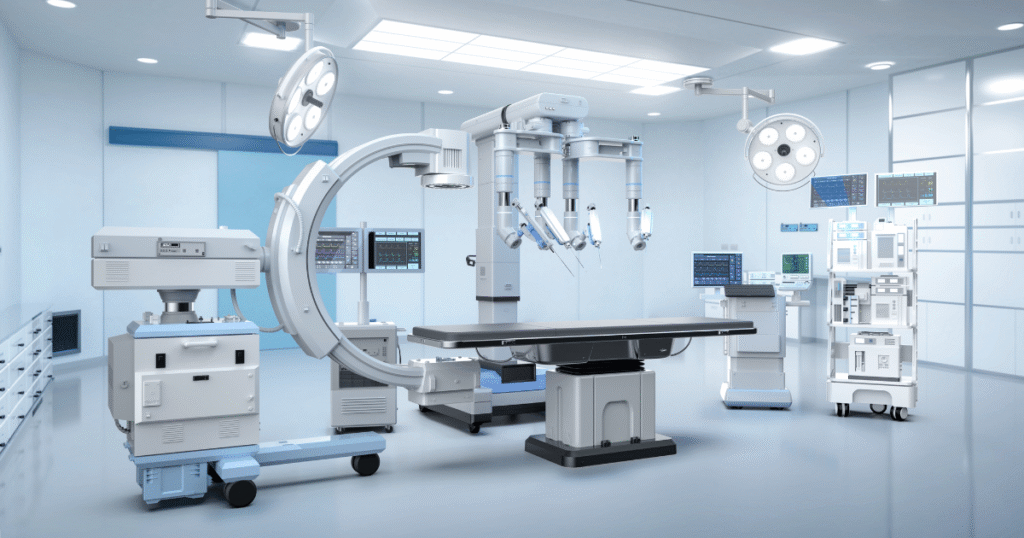The race for dominance in surgical robotics is heating up, and two names consistently stand out: Intuitive Surgical (ISRG) and Medtronic (MDT). These industry giants are at the forefront of robot-assisted surgery innovation, shaping the future of minimally invasive procedures. But as hospitals and healthcare systems face budget constraints, clinical expectations, and regulatory pressures, the question becomes: Who leads the race in 2025?
ISRG: The Titan of Robotic Surgery
Intuitive Surgical, the pioneer of robotic-assisted surgery, maintains a stronghold on the market with its Da Vinci Surgical System, which has now evolved through several generations. The Da Vinci Xi and Da Vinci SP models provide unparalleled precision, allowing for minimally invasive procedures across urology, gynecology, general surgery, and more.
- Market Share Leadership: As of 2025, Intuitive holds over 75% of the global surgical robotics market, with more than 8,000 Da Vinci systems installed worldwide.
- Clinical Evidence Backing: ISRG has published a robust body of clinical studies supporting the safety, efficacy, and cost-effectiveness of its platforms.
- Training and Ecosystem: Intuitive boasts a mature surgeon training program, along with Intuitive Hub, a cloud-connected ecosystem for real-time surgical insights and collaboration.
While competitors are catching up, ISRG’s early mover advantage, consistent innovation, and ecosystem depth continue to set it apart.
Medtronic: The Ambitious Challenger with Deep Resources
Medtronic has stepped into the surgical robotics domain with Hugo™ Robotic-Assisted Surgery (RAS) System, an advanced, modular platform targeting laparoscopic procedures. Despite launching years after Da Vinci, Hugo is gaining significant traction globally.
- Global Reach and Regulatory Progress: Hugo has now received regulatory approvals in over 60 countries, including EU CE Mark, Japan, and select regions in Latin America and Asia.
- Cost-Effectiveness Strategy: Medtronic positions Hugo as a lower-cost alternative to Da Vinci, appealing to hospitals in emerging markets or those with budgetary limitations.
- Data-Driven Innovation: Hugo’s Touch Surgery™ Enterprise platform enables cloud-based video capture and AI-powered analytics, aimed at improving surgeon performance and procedural efficiency.
While still building clinical momentum, Medtronic is leveraging its global supply chain, market penetration, and R&D firepower to challenge Intuitive Surgical’s dominance.
Head-to-Head Comparison: ISRG vs Medtronic
| Feature | Intuitive Surgical (Da Vinci) | Medtronic (Hugo RAS) |
| Market Share | ~75% globally | Rapidly growing in Asia, LATAM |
| Years in Market | Over 20 years | Launched commercially ~2021 |
| Procedure Volume (2024) | >2.3 million | Estimated ~100,000+ |
| Clinical Studies | 14,000+ peer-reviewed | Emerging clinical pipeline |
| Cost Model | Premium | Competitive pricing strategy |
| Training Program | Highly developed, global reach | Expanding with digital tools |
| Modularity | Fixed architecture | Modular, portable components |
| Cloud Integration | Intuitive Hub | Touch Surgery™ Enterprise |
Technology & Innovation: Precision Meets Portability
Intuitive Surgical’s systems are known for multi-quadrant access, EndoWrist® instruments, and 3D-HD vision, offering unmatched dexterity and vision. Da Vinci SP enables single-port surgeries, while the Xi continues to dominate multi-port procedures.
Medtronic’s Hugo, meanwhile, offers open-console design, surgeon ergonomics, and flexible cart-based architecture, which lowers OR space demands and enables customized setups per specialty. The video-based AI performance tracking is also a differentiator aimed at institution-level outcomes management.
While ISRG emphasizes depth of features and established trust, Medtronic focuses on agility, access, and tech convergence—a bet that could pay off as hospitals look for scalable solutions.
Regulatory Landscape and Global Expansion
Intuitive Surgical holds FDA clearances for multiple indications, giving it broad procedural versatility in the U.S. market. It is also aggressively expanding in Europe, Japan, and China, where surgical demand is skyrocketing.
Medtronic is pursuing a global-first approach, especially in Asia-Pacific and Latin America, regions that are underpenetrated by Da Vinci but eager for cost-effective, compliant robotic solutions. Their recent approvals in India and Brazil have fueled deployment growth in high-volume surgical centers.
Financial Performance: Comparing the Numbers
- ISRG Revenue (2024): $7.4 billion
- Medtronic Surgical Robotics Revenue (2024): Estimated ~$500 million (within the Minimally Invasive Therapies Group)
Intuitive’s financial lead is significant, but Medtronic’s investment pipeline, estimated at $1.2 billion over five years, signals long-term commitment.
ISRG’s recurring revenue from instrument and accessory sales also contributes a substantial margin, while Medtronic is still building a comparable razor-and-blade model.
Surgeon Adoption and Hospital Feedback

ISRG enjoys high surgeon loyalty due to decades of support, training, and refined instrumentation. Many leading institutions have integrated Da Vinci into residency programs.
However, Medtronic is strategically partnering with teaching hospitals and public health systems to win over the next generation of robotic surgeons. The modular training approach and remote mentoring systems are proving effective in low-resource environments.
Future Outlook: What Lies Ahead in the Robotics Race
Both companies are working toward next-generation platforms:
- ISRG is investing in AI-assisted autonomous movements, machine vision, and smart stapling systems.
- Medtronic is doubling down on mixed-reality integration, cloud-based learning, and robotic scalability in outpatient settings.
As healthcare shifts toward value-based care and ambulatory surgery centers, both players must adapt their systems to be faster, cheaper, and smarter. Emerging competitors like Johnson & Johnson’s Ottava and CMR Surgical’s Versius also add pressure to innovate.
Conclusion: The Robotics Crown is Still Contested
In 2025, Intuitive Surgical remains the undisputed leader in surgical robotics by volume, reputation, and ecosystem depth. But Medtronic is aggressively narrowing the gap, particularly in emerging markets and value-conscious institutions.
Ultimately, the winner in the surgical robotics race will be determined not just by market share, but by clinical outcomes, accessibility, affordability, and technological adaptability.


